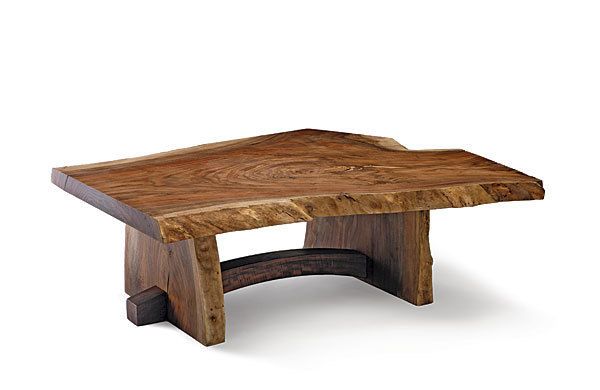Discover the Beauty of Big Slabs
Three experts share their best tips for finding and using these natural wonders
Synopsis: Three experts share their techniques and design insights for working with natural-edge slabs, a type of woodworking that is like no other. Along with stunning examples of their work, Nick Offerman, John Sterling, and Robert Ortiz discuss their design strategies, whether they tend toward beefy bases that echo the natural slab or more polished bases that contrast with it. They also provide advice on finding good slab wood and techniques on the best way to flatten these massive workpieces.
There is something about thick, natural-edge slabs that appeals to people of all backgrounds. Each one is unique, guaranteeing a one-of-a-kind result. Handled correctly, the wood becomes a beautiful marriage of nature and hand, with flat, shining surfaces meeting swirling grain, charming flaws, and organic edges.
We have George Nakashima to thank for introducing natural-edged slabs into modern woodworking, and since he passed away in 1990, woodworkers have been attempting to follow his masterful lead. I made an attempt myself, and while it contains a few missteps, I love that table, as does every visitor to my home.
From start to finish, working with these big planks is a little different from other types of woodworking. So I turned to three experts—Nick offerman (opposite page, bottom), robert ortiz (opposite page, top), and John C. Sterling (right)—for the tips and techniques they use to make the most of these natural masterpieces.
Three approaches to design
A natural-edged slab, floating over a trestle base, is a gorgeous modern sculpture upon which one can carve a side of beef or enjoy many fine whiskies. The thing I love the most about slab furniture is getting out of the way of Ma Nature and letting the beautiful grain and figure and color do the heavy lifting. Claro walnut is my favorite slab wood, closely followed by bigleaf maple. Both are incredibly strong, hard woods and yet easy to work, but it’s the candy-like quality of the grain and color variations in these species that float my boat. The walnut presents chocolate browns, complemented by purples and reds and even greenish grain variations that never fail to take my breath away, and the maple features different shades of reds and purples and oranges suspended in the creamy blond firmament of its expanse.
For the full article, download the PDF below:
Fine Woodworking Recommended Products

Dividers

Compass

Drafting Tools






















Log in or create an account to post a comment.
Sign up Log in